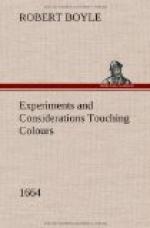13. Seventhly, And as by a Change of Position in the Parts, a Body that is not White, may be made White, so by a Slight change of the Texture of its Surface, a White Body may be Depriv’d of its Whiteness. For if, (as I have try’d in Gold-smiths Shops) you take a piece of Silver that has been freshly Boyl’d, as the Artificers call it, (which is done by, first Brushing, and then Decocting it with Salt and Tartar, and perhaps some other Ingredients) you shall find it to be of a Lovely White. But if you take a piece of Smooth Steel, and therewith Burnish a part of it, which may be presently done, you shall find that Part will Lose its Whiteness, and turn a Speculum, looking almost every where Dark, as other Looking-glasses do, which may not a little confirm our Doctrine. For by this we may guess, what it is chiefly that made the Body White before, by considering that all that was done to deprive it of that Whiteness, was only to Depress the Little Protuberances that were before on the Surface of the Silver into one Continu’d Superficies, and thereby effect this, that now the Image of the Lucid Body, and consequently a Kind of Whiteness shall appear to your Eye, but in some place of the greater Silver Looking-glass (whence the Beams reflected at an Angle Equal to that wherewith they fall on it, may reach your Eye) whilst the Asperity remain’d Undestroy’d, the Light falling on innumerable Little Specula Obverted some one way, and some another, did from all Sensibly Distinguishable parts of the Superficies reflect confus’d Beams or Representations of Light to the Beholders Eye, from whence soever he chance to Look upon it. And among the Experiments annex’d to this Discourse, you will find One, wherein by the Change of Texture in Bodies, Whiteness is in a Trice both Generated and Destroy’d.
* * * * *
CHAP. II.
1. What we have Discours’d of Whiteness, may somewhat Assist us to form a Notion of Blackness, those two Qualities being Contrary enough to Illustrate each other. Yet among the Antient Philosophers I find less Assistance to form a Notion of Blackness than of Whiteness, only Democritus in the passage above Recited out of Aristotle has given a General Hint of the Cause of this Colour, by referring the Blackness of Bodies to their Asperity. But this I call but a General Hint, because those Bodies that are Green, and Purple, and Blew, seem to be so as well as Black ones, upon the Account of their Superficial Asperity. But among the Moderns, the formerly mention’d Gassendus, perhaps invited by this Hint of Democritus, has Incidentally in another Epistle given us, though a very Short, yet a somewhat Clearer account of the Nature of Blackness in these words: Existimare par est corpora suapte Natura nigra constare ex particulis, quarum Superficieculae scabrae sint, nec facile lucem extrorsum reflectant. I wish this Ingenious Man had enlarg’d




